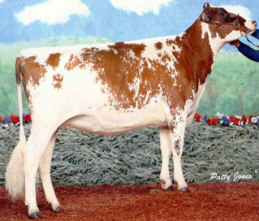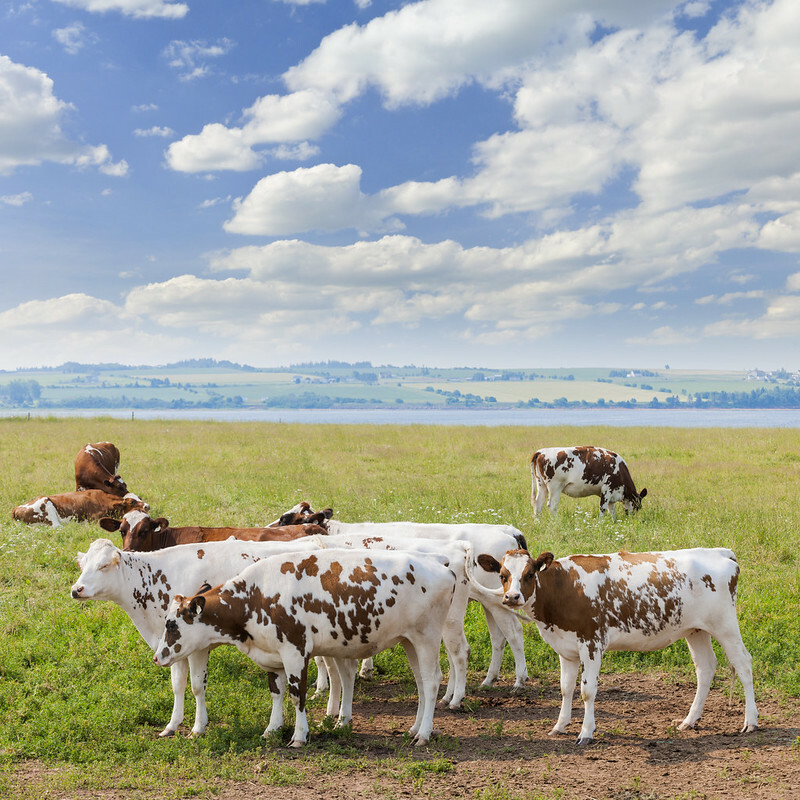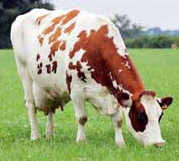



Ayrshire
History
The Ayrshire breed originated in the County of Ayr in Scotland, prior to 1800 and was regarded as an established breed by 1812. During its development, it was referred to first as the Dunlop, then the Cunningham, and finally, the Ayrshire. How the different strains of cattle were crossed to form the breed known as Ayrshire is not exactly known. There is good evidence that several breeds were crossed with native cattle to create the foundation animals of the breed. In Agriculture, Ancient and Modern, published in 1866, Samual Copland describes the native cattle of the region as "diminutive in size, ill-fed, and bad milkers." Prior to 1800 many of the cattle of Ayrshire were black, although by 1775 browns and mottled colours started to appear.
The improvement of the native stock is thought to of begun around 1750 when it was crossed with other breeds such as the Teeswater cattle and Channel Islands cattle.
Regardless of the details of origin, the early breeders carefully crossed and selected the various strains of cattle to develop the cow we now know as the Ayrshire. She was well suited for the land and climate in Ayr. The Ayrshire is an efficient grazer; noted for her vigour and efficiency of milk production. Ayrshire's are especially noted for the superior shape and quality of the udder. The composition of the milk made it ideally suited for the production of butter and cheese by the early Scottish dairymen.

Photo courtesy of Topline Ayrshires, www.toplineayrshires.com |
Many changes have taken place during the late 1980's and early 1990's which have affected the numbers of Ayrshires (and all other breeds) leading to a decrease. Much of this is due to increased profitability of all dairy cows, which has led to an over-supply of milk to the domestic market. However, careful management has convinced Ayrshire breeders that their chosen breed has served them well, and will continue to do so in the future.
Characteristics

Ayrshires are red and white in colour. The red colour is a reddish-brown mahogany that varies in shade from very light to very dark. On some bulls, the mahogany colour is so dark that it appears almost black in contrast to the white. The colour markings vary from nearly all red to nearly all white. The spots are usually very jagged at the edges and often small and scattered over the entire body of the cow. Usually, the spots are distinct, with a break between the red and the white hair. Some Ayrshires exhibit a speckled pattern of red pigmentation on the skin covered by white hair. Brindle and roan colour patterns were once more common in Ayrshires, but these patterns are rare today.
For many years, the Ayrshire horns were a hallmark of the breed. These horns often reached a foot or more in length, they gracefully curved out and then up and slightly back. When polished for the show ring, the Ayrshire horns were a spectacular sight. Horns are not very practical, and today almost all Ayrshires are dehorned as calves.
Ayrshires are medium-sized cattle and weigh approximately over 1200 pounds at maturity. They are strong, rugged cattle that adapt to all management systems including group handling on dairy farms with free stalls and milking parlors. Ayrshires excel in udder conformation and are not subject to excessive foot and leg problems.
Few other breeds can match the ability of the Ayrshire to rustle and forage for themselves under adverse feeding or climatic conditions. The ruggedness of the terrain and the unfavourable climatic conditions of their native land led to the selection for those points of hardiness that adapt them to less than ideal conditions. These traits make Ayrshires outstanding commercial dairy cattle.
Other traits that make Ayrshires attractive to the commercial dairyman include the vigor of Ayrshire calves. They are strong and easy to raise. Ayrshires do no possess the yellow tallow characteristic that would reduce carcass value, so Ayrshire bull calves can be profitably raised as steers.
The Ayrshire is a moderate butterfat breed. Top producing Ayrshires regularly exceed 20,000 pounds of milk in their lactations. The current world record for Ayrshire is held by Lette Farms Betty's Ida. In 305 days, on twice-a-day milking, she produced 37,170 pounds of milk and 1592 pounds of fat. The Ayrshire Breeders' Association does not officially recognize records in excess of 305 days, but one Ayrshire has produced over 41,000 pounds of milk and 1800 pounds of butterfat in 365 days.
Statistics
They are known for low somatic cell counts, ability to convert grass into milk efficiently, and hardiness. The breeds strong points are the now desired traits of easy calving and longevity, Ayrshires are also free of genetic disease.
Ayrshire milk is referred to as "the ideal drinking milk". Their milk is not excessively rich, not lacking adequate fat, and it possesses quantities of desirable non-fat solids such as protein.
In South Africa, a chain of large upscale stores selling only high quality products had their cliental taste different kinds of dairy milk (Ayrshire, Holstein, and Jersey). Over 70% preferred the taste of Ayrshire milk over all the other milk. As well, the high fat, protein and kappa casein in Ayrshire milk is a more desirable milk for conversion into yogurt, cheese and ice cream because the particles of fat are slightly smaller and better distributed throughout the milk.
The actual average of all Ayrshires on Official DHIR test is over 12,000 pounds of milk with a 3.9% test.
Ayrshires respond to good management and feeding practices and individual Ayrshire herds average as high as 17,000 pounds of milk and 700 pounds of butterfat.
These days it is not rare to see an Ayrshire cow producing over 10, 000 kg of milk per lactation or 80, 000 kg or more in a lifetime.
Distribution
Ayrshires remain popular in many countries such as Russia, North America, Britain, Australia, New Zealand, Africa and parts of Europe and South America.
References (the above information was cited from the following sites)


